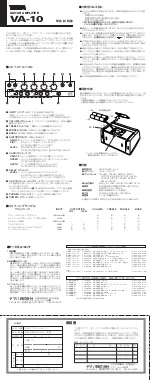
PSR-E283 YPT-280 Reference Manual
36
Troubleshooting
Problem
Possible Cause and Solution
When you press the [ ] (Standby/On) switch to turn on
or turn off the power, a popping sound is temporarily
produced.
This is normal and indicates that the instrument is receiving electrical power.
Noise is heard from the instrument’s speakers or
headphones when using a mobile phone (or the mobile
phone is ringing) near this instrument.
Turn off your mobile phone. If you use a mobile phone near this instrument,
noise may be heard.
Noise is heard from the instrument’s speakers or
headphones when using the instrument with an
application on a smart device.
When you use the instrument along with an application on your smart device, we
recommend that you set “Airplane Mode” to “ON” on your smart device in order to
avoid noise caused by communication.
No sound is heard from the instrument’s speakers even
when the keyboard is played or when a Song or Style is
being played back.
Check that nothing is connected to the [PHONES/OUTPUT] jack on the rear panel.
When a set of headphones is plugged into this jack, no sound is output.
Some keys played at the same time do not sound.
When you play the keyboard, the Song or Style
performance sound or metronome sound is interrupted.
The maximum number of simultaneous polyphony (32 notes) for this instrument
has been exceeded.
You can play up to 32 notes, including Song, Style, metronome, etc. If this amount
is exceeded to 33 or more notes, some of the sounds being produced will be
cancelled.
The sound volume does not change, regardless of how
strongly or softly you play the keyboard.
Since this keyboard does not have touch response, the level of the sound does
not change in response to your playing strength.
The
icon does not appear when
[ACMP ON/OFF]
!2
is pressed.
• Always press [STYLE]
!3
first when you are going to use any Style-related
function.
• The icon does not appear when the Duo mode is turned on.
Styles are not playing correctly.
Make sure that the Style Volume is set to an appropriate level (page 32,
Function number 008).
Make sure that the split point is set to an appropriate position for the chords you
are playing in “Function Settings” (page 32, Function number 003).
If the
icon is not shown on the display, press [ACMP ON/OFF]
!2
again so
that it does appear.
The Style is not playing as you play a chord.
• The Auto Accompaniment will sometimes not change when related chords are
played in sequence (e.g., some minor chords followed by the minor seventh with
the same root note).
• Two-note fingerings will produce a chord based on the previously played chord.
• Playing two same-root keys in the adjacent octaves produces accompaniment
based only on the root.
The foot switch (for sustain) seems to produce the
opposite effect. For example, pressing the foot switch
cuts off the sound, and releasing it sustains the sound.
This is because you connected the foot switch after turning on the power or
turned on the power while stepping on the foot switch.
Connect the foot switch with the power turned off, and then turn on the power
without stepping on the foot switch.
The sound quality and volume change depending on the
key you play.
This is normal. The AWM sound source system adopted in this instrument uses a
method called “multi-sampling,” which divides the keyboard into several sections
and samples the instrument’s sound, in order to enable realistic instrument
expression. Thus, the quality and volume of these Voices may vary slightly
depending on the range.
• The volume is too soft.
• The sound quality is poor.
• The rhythm stops unexpectedly or will not play.
• Songs, etc. are not played correctly.
• The LCD display suddenly goes dark, and all panel
settings are reset.
The batteries are low or depleted. Replace all six batteries with completely new
ones, or use the included AC adaptor.
Содержание PSR-E283
Страница 1: ...DIGITAL KEYBOARD REFERENCE MANUAL...
Страница 50: ...2024 Yamaha Corporation Published 02 2024 II B0...















































